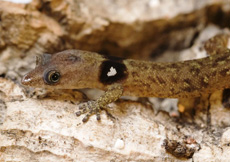Sphaerodactylus vincenti
(KING, 1962)
Distribution:
The distribution area of Sphaerodactylus vincenti extends to the Caribbean islands of Dominica, St. Vincent, Martinique and St. Lucia. The nominate form only occurs on St. Vincent.
Description:
There are a number of subspecies which differ greatly in their pattern. The distinctive eye-spot on the neck should not generally serve as a distinguishing feature over other Sphaerodactylus types. For example Sphaerodactylus vincenti ronaldi has pronounced eye-spots on the neck, while in Sphaerodactylus vincenti josephinae this is not the case. These also should not be a distinction between the different sexes. In some subspecies the differences are minor and the females may have completely closed, missing or inconspicuous eye-spots. A fundamental distinguishing feature of all ball fingered geckos is the presence of the Escutcheon; a series of shiny unpigmented scales between the legs on males. The basic color of all subspecies of Sphaerodactylus vincenti is brown with various shades of darker or lighter brown marbling. The head and tail are red-brown in color. Some subspecies have two bright v-shaped tapered lines on the head or tail. There is also a high variability regarding the color of the iris, tongue and belly. Sphaerodactylus vincenti have a SVL of 40 millimeters and are in the larger member group of the genus Sphaerodactylus.
Habitat:
Sphaerodactylus vincenti is found basically wherever continuous humidity is provided; on the rainforest floor in leaf litter, nearby streams where they are content on stones, near brooks on the exposed roots of trees and on or under woody debris. Direct sunlight is avoided by the animals. Sphaerodactylus vincenti is also quite content in climbing and therefore it may also be found in an elevated position.
Husbandry and Breeding:
A pair may be kept in a terrarium measuring 40x40x30 centimeters. In an terrarium decorated in the following manner Sphaerodactylus vincenti is easily observed and at feeding time the animals almost lose any shyness they have and come out of hiding when you open the front door. The rear and side walls may be made up of Styrofoam covered in sphagnum peat moss, medium sized stones can also be integrated in to this design. As another example, the terrarium decoration should imitate the bank area of a stream. A large tree root to offer an additional climbing opportunity should not be missing from the terrarium decor. The ground surface can be divided into two areas: One area gravel and larger stones, the other soil and leaves. When planting the terrarium a large Tillandsia and a climbing plant such as a Tradescantia will be sufficient. A small water bowl and a bowl of crushed up cuttlefish bone are a must in completing the setup. Illumination of the terrarium is provided for 12 hours daily with a T5 tube rated for daylight color, a reflector should also be used in conjunction with the lamp. The average daytime temperature should range between 25-28°C (77 -82°F). At night the temperature drops by about three to four degrees. Since the animals do not use the sun to reach their preferred body temperature, the attachment of a halogen spot is unnecessary. Once or twice a day the terrarium should be misted, as the soil should always be kept slightly moist. Prey items such as small and large fruit flies, springtails, firebrats, isopods and micro crickets are offered twice weekly. All food should be dusted with the appropriate supplements at every feeding. Females are sexually mature between 19 and 20 months. After successful fertilization the female will lay at regular intervals a large egg measuring about 7.5x6 millimeters. This is preferably stored in the leaf axils or leaves of the Tillandsia. At a temperature of 28°C (82°F) the young emerge after about 60 days, the young measure around 20 millimeters. The young are right away as colorful as the adult animals. The young animals can be raised in converted household containers. The containers should be setup with soil, a piece of cork or bark and leaves. At first they should only be offered springtails and newly hatched firebrats, later on small fruit flies may also be provided as food. Like with the adults, all prey items should be dusted with the appropriate supplements at every feeding.
Sphaerodactylus vincenti poses no problems in keeping or breeding and is therefore also suitable for beginners.





